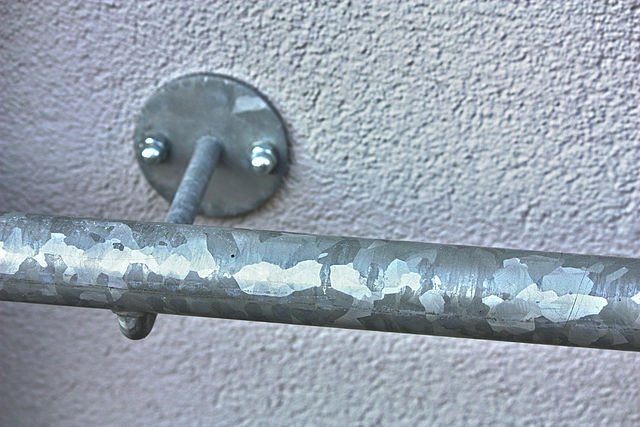Loading AI tools
Process of layering steel or iron with zinc to prevent rusting From Wikipedia, the free encyclopedia
Galvanization (also spelled galvanisation)[1] is the process of applying a protective zinc coating to steel or iron, to prevent rusting. The most common method is hot-dip galvanizing, in which the parts are coated by submerging them in a bath of hot, molten zinc.[citation needed]

The zinc coating, when intact, prevents corrosive substances from reaching the underlying iron.[2] Additional electroplating such as a chromate conversion coating may be applied to provide further surface passivation to the substrate material.[3]

The process is named after the Italian physician, physicist, biologist and philosopher Luigi Galvani (9 September 1737 – 4 December 1798). The earliest known example of galvanized iron was discovered on 17th-century Indian armour in the Royal Armouries Museum collection in the United Kingdom.[4]
The term "galvanized" can also be used metaphorically of any stimulus which results in activity by a person or group of people.[5]
In modern usage, the term "galvanizing" has largely come to be associated with zinc coatings, to the exclusion of other metals. Galvanic paint, a precursor to hot-dip galvanizing, was patented by Stanislas Sorel, of Paris, on June 10, 1837, as an adoption of a term from a highly fashionable field of contemporary science, despite having no evident relation to it.[6]
Hot-dip galvanizing deposits a thick, robust layer of zinc iron alloys on the surface of a steel item. In the case of automobile bodies, where additional decorative coatings of paint will be applied, a thinner form of galvanizing is applied by electrogalvanizing. The hot-dip process generally does not reduce strength to a measurable degree, with the exception of high-strength steels where hydrogen embrittlement can become a problem.[7]
Thermal diffusion galvanizing, or Sherardizing, provides a zinc diffusion coating on iron- or copper-based materials.[8][9]

Galvanized steel can last for many decades if other supplementary measures are maintained, such as paint coatings and additional sacrificial anodes. Corrosion in non-salty environments is caused mainly by levels of sulfur dioxide in the air.[10]
This is the most common use for galvanized metal; hundreds of thousands of tons of steel products are galvanized annually worldwide. In developed countries, most larger cities have several galvanizing factories, and many items of steel manufacture are galvanized for protection. Typically these include street furniture, building frameworks, balconies, verandahs, staircases, ladders, walkways, and more. Hot dip galvanized steel is also used for making steel frames as a basic construction material for steel frame buildings.[11]
In the early 20th century, galvanized piping swiftly took the place of previously used cast iron and lead in cold-water plumbing. Practically, galvanized piping rusts from the inside out, building up layers of plaque on the inside of the piping, causing both water pressure problems and eventual pipe failure. These plaques can flake off, leading to visible impurities in water and a slight metallic taste. The life expectancy of galvanized piping is about 40–50 years,[12] but it may vary on how well the pipes were built and installed. Pipe longevity also depends on the thickness of zinc in the original galvanizing, which ranges on a scale from G01 to G360.[13]
Seamless Wikipedia browsing. On steroids.
Every time you click a link to Wikipedia, Wiktionary or Wikiquote in your browser's search results, it will show the modern Wikiwand interface.
Wikiwand extension is a five stars, simple, with minimum permission required to keep your browsing private, safe and transparent.